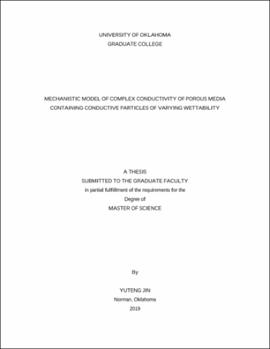| dc.description.abstract | Electrically conductive particles, such as graphite and pyrite particles, and surface-charge-bearing nonconductive particles, such as sand and clay grains, are commonly present in subsurface geological formations. When a fluid-filled porous geomaterial is exposed to an external electromagnetic (EM) field generated by electromagnetic measurement tool, the constituent conductive and non-conductive particles surrounded by in situ brine give rise to interfacial polarization (IFP) effects, which cause frequency dispersions of effective conductivity and effective permittivity of the fluid-filled porous geomaterials. IFP effects when neglected lead to inaccurate interpretation of electromagnetic logs/measurements, especially in clay-, graphite- and pyrite- rich formations. Also, there is no mechanistic model that accounts for the effect of wettability of conductive particles and surface-charge-bearing particles on the electromagnetic logs/measurements of geomaterials.
This thesis describes a mechanistic model (namely PS model) that couple surface-conductance-assisted interfacial polarization (SCAIP) model with perfectly polarized interfacial polarization (PPIP) model to estimate effective conductivity and effective permittivity of shale formations containing both nonconductive and conductive particles at various fluids saturations. The model is developed based on the Poisson-Nernst-Planck (PNP) equations for a dilute solution in a weak electrical field regime to calculate the dipolarizability of the representative volume comprising a single isolated spherical particle in an electrolyte host. Then the effective medium theory is used to determine effective complex conductivity of the whole mixture. The PS model is further improved to consider the wettability effect by introducing a wettability model, which is developed based on the solution of the Young-Laplace equation that determines the shape of the oil-water interface (meniscus) at equilibrium.
The model shows that the IFP effects of conductive particles dominate the frequency dispersions of complex conductivity as compared to nonconductive particles. Also, the frequency dispersion reduces as contact angle or oil saturation increases, and the effect of oil saturation on the frequency dispersions of complex conductivity is less than the effect of contact angle (i.e. the contact angle plays a primary effect and oil saturation plays a secondary effect). At the end of this thesis, a Markov chain Monte Carlo (MCMC) inversion method is coupled with the PS model to process the multifrequency electromagnetic logs/measurements to estimate oil saturation, contact angle and conductivity of brine. | en_US |
